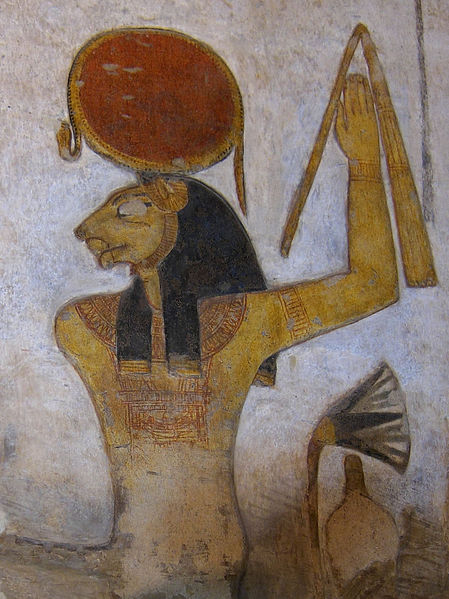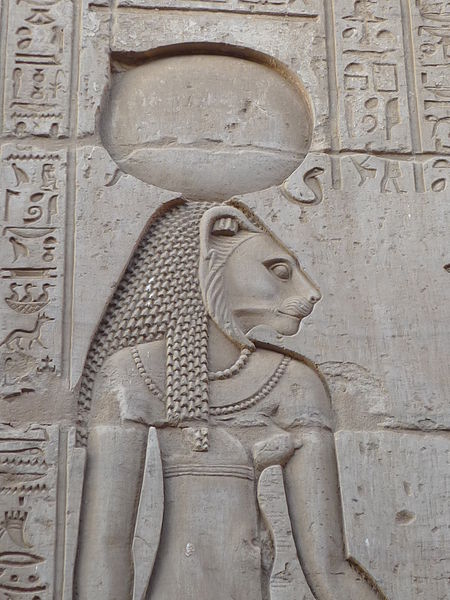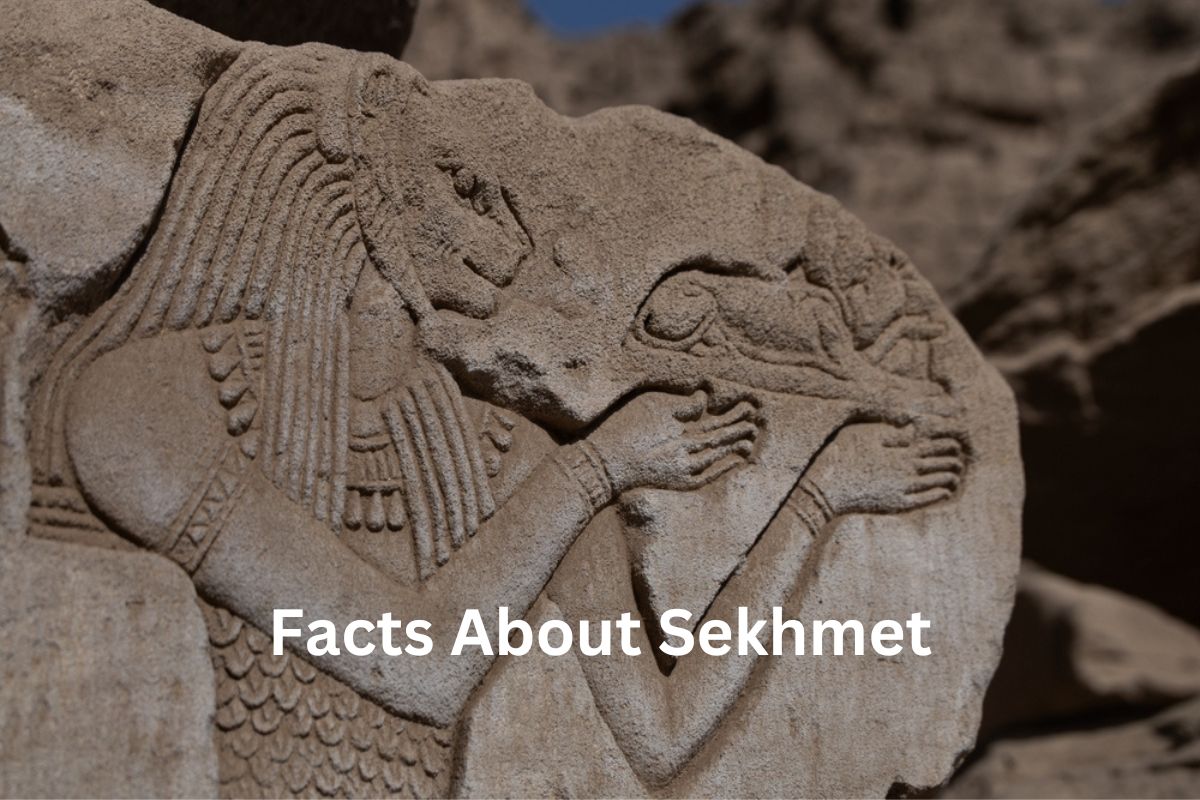Sekhmet is an ancient Egyptian goddess associated with war, destruction, and healing. She was depicted as a lioness-headed woman or a full lioness, symbolizing her strength and ferocity.
As the daughter or manifestation of the sun god Ra, Sekhmet was revered for her power and connection to solar energy. She served as a protector of the pharaoh and the kingdom, with the ability to bring victory in battles.
However, she also possessed a dual nature, capable of unleashing plagues and epidemics as well as providing healing and curing diseases. Temples dedicated to Sekhmet served as centers for healing, and she was invoked by priests and priestesses who practiced medicine.
Sekhmet’s mythology includes the famous tale of the “Destruction of Mankind,” where she went on a rampage but was eventually calmed through a clever trick by Ra.
Despite her destructive nature, Sekhmet was also associated with fertility and the cycle of life. Today, she continues to inspire and be honored by those who appreciate her complex nature and powerful symbolism.

Sekhmet Facts
1. Sekhmet is an ancient Egyptian goddess who was associated with war, destruction, and healing
Sekhmet is an ancient Egyptian goddess who was associated with war, destruction, and healing. She held a prominent position within the Egyptian pantheon and was revered for her strength and ferocity.
Sekhmet was often depicted as a lioness-headed woman or as a full lioness, showcasing her connection to the powerful and untamed nature of the lion.
2. Her name, Sekhmet, means “the powerful one” or “the mighty one”
The name “Sekhmet” derives from the Egyptian term “sekhem,” which means power or might. It reflects her role as a formidable deity who possessed immense strength and authority.
As the goddess of war, Sekhmet was believed to have the ability to unleash devastation and wreak havoc on her enemies. Her presence was seen as a force to be reckoned with, capable of turning the tides of battles and protecting the pharaoh and the kingdom.
3. Sekhmet was closely linked to the sun god Ra, and she was considered his daughter or a manifestation of his power
Sekhmet was closely linked to the sun god Ra, one of the most important deities in the Egyptian pantheon. She was often considered to be Ra’s daughter or a manifestation of his power. Sekhmet was frequently referred to as the “eye of Ra” or the “avenger of the sun god.”
This connection emphasized her role as a defender and protector of Ra and his divine authority. She was believed to be an instrument of his wrath, punishing those who defied or threatened the sun god.
The association with Ra also highlighted the solar aspect of Sekhmet. Like the sun, she possessed immense energy and radiance, but she could also unleash destructive forces if angered or provoked.
This connection to the sun also contributed to her role in healing, as the sun was considered a source of life and vitality in ancient Egypt.
4. As a war goddess, Sekhmet was believed to protect the pharaoh and the kingdom from enemies
Sekhmet was not only a war goddess but also a guardian and protector of the Egyptian people. She was called upon in times of conflict to bring victory and ensure the safety of the pharaoh and the kingdom.
As a symbol of divine power, she instilled fear in the hearts of enemies and was believed to aid in the defense of the land.

5. Sekhmet was associated with both destructive and healing aspects
One of the fascinating aspects of Sekhmet’s mythology is her duality of destructive and healing powers. While she was feared for her capacity to unleash plagues and epidemics, she also possessed the ability to heal and cure diseases.
In times of illness and suffering, prayers and rituals were performed to invoke Sekhmet’s healing attributes. Her power to inflict and alleviate suffering made her a complex deity associated with both the infliction of punishment and the granting of relief.
6. Temples dedicated to Sekhmet were built throughout ancient Egypt, with her main cult center located in Memphis
Temples dedicated to Sekhmet were constructed throughout ancient Egypt, with her primary cult center located in Memphis. These temples served as important centers for healing and medical practices.
Priests and priestesses of Sekhmet were skilled in medicine and acted as healers, attending to the needs of the sick and injured. Rituals and ceremonies were performed to invoke Sekhmet’s benevolent aspect, seeking her intervention and assistance in the healing process.
These priests and priestesses also played a crucial role in maintaining the balance between Sekhmet’s destructive and healing powers, ensuring that her wrath was appeased and her healing abilities were channeled appropriately.
7. In some myths, Sekhmet’s destructive nature was depicted in the story of the “Destruction of Mankind”
The story of the “Destruction of Mankind” is one of the most well-known myths associated with Sekhmet. According to this myth, Ra, the sun god, became displeased with humanity due to their disobedience and disrespect.
In his anger, he dispatched Sekhmet to punish humanity and teach them a lesson. Sekhmet went on a rampage, slaughtering humans and causing immense bloodshed. However, her bloodlust became insatiable, and it seemed like she would eradicate all of humanity.
To prevent further destruction, Ra devised a plan. He ordered his servants to mix beer with pomegranate juice to resemble blood and spread it across the land.
Sekhmet, mistaking the concoction for blood, became intoxicated and eventually ceased her rampage. This story showcases both Sekhmet’s destructive nature and the cunning of Ra in finding a way to subdue her.
8. Despite her fierce and destructive nature, Sekhmet was also associated with fertility and the cycle of life
Despite her association with destruction, Sekhmet also possessed aspects related to fertility and the cycle of life. She was sometimes called upon to assist in the process of childbirth and protect pregnant women.
It was believed that Sekhmet’s fierce nature could be channeled to safeguard the vulnerable stages of life, ensuring the successful birth of children and the well-being of mothers.
9. Sekhmet was often depicted wearing a sun disk and cobra on her head
Sekhmet’s depictions in ancient Egyptian art often featured her wearing a sun disk and cobra on her head. The sun disk symbolized her association with the sun god Ra and her connection to solar power and divine radiance.
The cobra, known as the uraeus, was a symbol of protection and royalty in ancient Egypt, signifying Sekhmet’s role as a guardian and defender of pharaohs and the kingdom.
Additionally, Sekhmet was often depicted carrying a scepter or ankh, both of which were symbols of authority and divine power in Egyptian iconography.
10. Today, Sekhmet is still honored and worshiped by some modern practitioners of Egyptian-based Neopaganism
In contemporary times, Sekhmet continues to be honored and worshipped by various individuals and groups. Modern practitioners of Egyptian-based Neopaganism and those who follow esoteric traditions often incorporate Sekhmet into their practices.
Her image and symbolism have inspired artists, writers, and spiritual seekers, as her complex nature embodies both destructive power and healing abilities. Many are drawn to her as a representation of personal strength, courage, and the potential for transformation. Sekhmet’s ancient legacy has transcended time and continues to captivate and resonate with people today.
